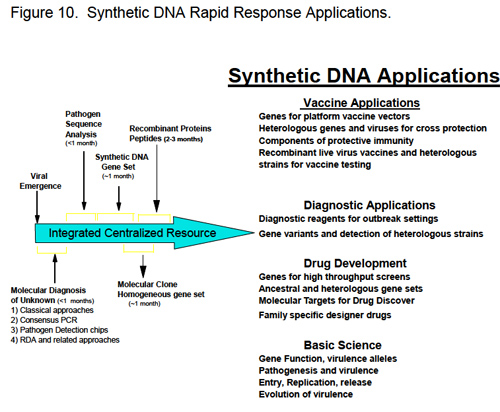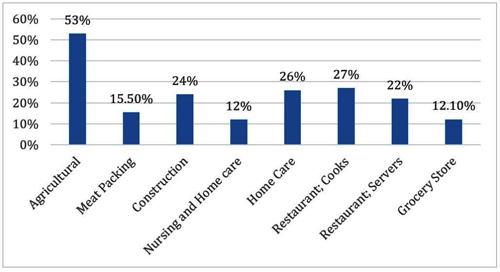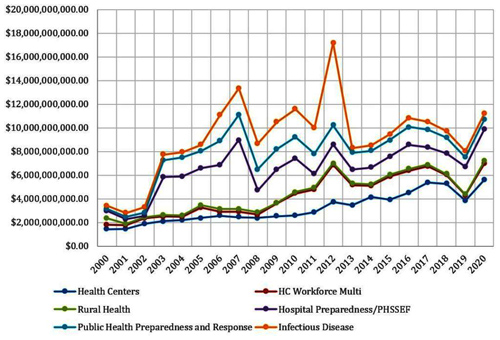Synthetic Viral Genomics: Risks and Benefits for Science and Society
by Ralph S. Baric
University of North Carolina at Chapel Hill
2007
NOTICE: THIS WORK MAY BE PROTECTED BY COPYRIGHT
YOU ARE REQUIRED TO READ THE COPYRIGHT NOTICE AT THIS LINK BEFORE YOU READ THE FOLLOWING WORK, THAT IS AVAILABLE SOLELY FOR PRIVATE STUDY, SCHOLARSHIP OR RESEARCH PURSUANT TO 17 U.S.C. SECTION 107 AND 108. IN THE EVENT THAT THE LIBRARY DETERMINES THAT UNLAWFUL COPYING OF THIS WORK HAS OCCURRED, THE LIBRARY HAS THE RIGHT TO BLOCK THE I.P. ADDRESS AT WHICH THE UNLAWFUL COPYING APPEARED TO HAVE OCCURRED. THANK YOU FOR RESPECTING THE RIGHTS OF COPYRIGHT OWNERS.
Cite as: Baric RS. 2006. Synthetic Viral Genomics. In: Working Papers for Synthetic Genomics: Risks and Benefits for Science and Society, pp. 35-81. Garfinkel MS, Endy D, Epstein GL, Friedman RM, editors. 2007.
I. Introduction
A. Viruses and Biological Warfare
Viral disease outbreaks have long inspired fear in human populations. Highly pathogenic infectious disease has shaped world history, primarily by impacting the outcome of wars and other global conflicts and precipitating human movement. Historic accounts have documented the catastrophic consequences and human suffering associated with widespread viral outbreaks like smallpox virus, yellow fever virus, measles virus, human immunodeficiency virus (HIV), the severe acute respiratory syndrome coronavirus (SARS-CoV), the 1918 influenza virus and others (51). News accounts and film have reinforced the serious threat posed by the emergence of new viral diseases as well as the catastrophic consequences of intentional release of highly pathogenic viruses in human populations. As illustrated by the SARS epidemic and the continuing evolution of the H5N1 avian influenza, global and national infectious disease outbreaks can overwhelm disaster medical response networks and medical facilities, disrupt global economies, and paralyze health and medical services by targeting health care workers and medical staff (21). This review focuses on viruses of humans, animals and plants that are viewed as potential weapons of mass disruption to human populations, critical plant and animal food sources, and national economies; and will consider whether and how the availability of synthetic genomics technologies will change this landscape.
Biological warfare (BW) agents are microorganisms or toxins that are intended to kill, injure or incapacitate the enemy, elicit fear and devastate national economies. Because small amounts of microorganisms might cause high numbers of casualties, they are classified as weapons of mass destruction. A number of naturally occurring viruses have potential uses as BW agents, although the availability of these agents is oftentimes limited. This report discusses the potential use of recombinant and synthetic DNAs to resurrect recombinant BW viruses de novo and the potential for altering the pathogenic properties of viruses for nefarious purposes. Examples of weaponized viruses include Variola major (Smallpox), Venezuelan equine encephalitis virus (VEE), and the filoviruses Marburg and Ebola viruses, with the classic example being the use of smallpox virus-contaminated blankets against indigenous North American Indian populations (76). It is now clear that many viruses possess properties consistent with applications in biological warfare and bioterrorism.
B. Properties of Select BW Agents
Traditionally, biological warfare concerns have focused on a relatively limited, select group of naturally occurring pathogens viewed as having a set of desirable characteristics: 1) highly pathogenic, 2) readily available, 3) easily produced, 4) weaponizable, 5) stable, 6) infectious at a low dose, 7) easily transmissible, and 8) inspiring of fear (32). Viruses of concern include pathogens that replicate and produce serious morbidity and mortality in humans to pathogens that target farm animals and plants of economic importance. Historically, weaponization of agents has been constrained by availability, the biological characteristics specified within the genome of these organisms, the ability to replicate and produce large quantities of the material, and by the lack of appropriate associated technologies. Culture (growth) and containment conditions for most of the virus agents of concern have been solved and are readily available in the literature. Natural hosts and reservoirs of many viral agents have been identified, providing a means of readily acquiring these pathogens in nature, although this is not always the case. Most recently, full length genome sequences have been solved for many important human, animal and plant pathogens, providing a genetic template for understanding the molecular mechanisms of pathogenesis and replication. Structural studies have identified contact points between the virus and the host receptors needed for docking and entry, providing the means to humanize animal pathogens (42). With the advent of synthetic biology, recombinant DNA technology, reverse genetic approaches (i.e. the development of molecular clones of infectious genomes) and the identification of virulence alleles, not only are new avenues available for obtaining these pathogens, but more ominously, tools exist for simultaneously modifying the genomes for increased virulence, immunogenicity, transmissibility, host range and pathogenesis (22, 59). Moreover, these approaches can be used to molecularly resurrect extinct human and animal pathogens, like the 1918 human influenza virus (81).
National biodefense strategies are focused on threats posed by this small group of plant, animal and human pathogens that occur in nature. However, counterterrorism think-tanks anticipate that these particular threats will ameliorate over the next decade because of medical countermeasures (e.g., drugs, vaccines, diagnostics), coupled with a limited set of pathogens that include all of the biological warfare characteristics. More important, the anticipated long-term threat in biological warfare is in recognizing and designing countermeasures to protect against genetically modified and designer pathogens, made possible by newly emerging technologies in recombinant DNA, synthetic biology, reverse genetics and directed evolution (59). How will synthetic genomics effect future biological weapons development? What are the risks and benefits of these new technologies and how serious a threat do they pose for human health and the global economy? This paper builds upon earlier work and seeks to review the methodologies in isolating recombinant viruses in vitro and the application of these methods globally to biological warfare and biodefense (27).
II. Virus Classification and Reverse Genetic Approaches
A. Overview of Virus Classification and Reverse Genetics
From the genome, all viruses must generate a positive strand mRNA that is translated into proteins essential for genome replication and the assembly and formation of progeny virions. Depending upon the nature of the genome, all viruses can be clustered into seven fundamentally different groups, which utilize different strategies to synthesize mRNA from the input genome, a scheme called the Baltimore Classification (Figure 1).1 Because virus infectivity is dependent upon the ability to transcribe mRNAs, reverse genetic strategies are designed to insure expression of critical viral mRNAs that encode essential replicase proteins needed to “boot” (initiate) genome infectivity and initiate genome replication.
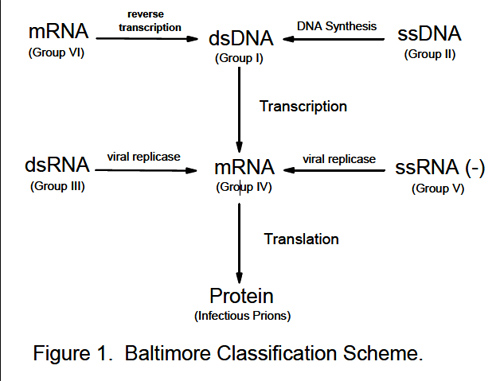
Figure 1. Baltimore Classification Scheme
Group I viruses include the double-stranded DNA (dsDNA) viruses, like the Herpes viruses and Poxviruses which replicate in the nucleus or cytoplasm, respectively. The dsDNA viruses use cellular and/or virally-encoded transcriptase components to mediate expression of viral mRNAs. Poxviruses for instance require one or more viral proteins to initiate mRNA transcription and boot infectivity of the viral genome. Hence, smallpox virus genomes are not infectious unless the appropriate suite of viral proteins is provided in trans (in addition to the genome itself). In contrast, the Herpes virus genome is infectious in the absence of any viral proteins as cellular transcriptase machinery induces expression of early mRNAs and proteins that regulate expression of other viral genes and replication. Using vaccinia (poxvirus) as a model, an approach to successfully initiate/jump start and boot the infectivity of poxviruses has been developed, providing a template strategy for the family (11, 24). Herpes virus genomes are infectious in the absence of additional viral factors. Group II viruses encode single stranded DNA genomes which must be used as templates for the synthesis of a dsDNA before transcription and translation of mRNAs can occur within cells. At this time, group II BW agents have not been identified.
The Group III viruses contain double stranded RNA viruses, like reoviruses. Reovirus genomes consist of complementary positive and negative strands of RNA that are bound by hydrogen bonding, wrapped within a multistructured icosahedral core that is essential for virus transcription. The virion structure contains the necessary proteins required for initiating mRNA synthesis. Unlike many of the single-stranded RNA viruses, the dsRNA virus genomes are not infectious in isolation and the components necessary for booting genome infectivity remain unresolved.
Group IV viruses contain a single-stranded positive polarity RNA genome and include the flaviviruses, alphaviruses, picornaviruses (including poliovirus), coronaviruses (including the SARS virus), caliciviruses and others. Upon entry into cells, positive strand RNA genomes are immediately recognized by host translational machinery and the genome is translated into a suite of viral proteins, including the replicase proteins and RNA-dependent RNA polymerase which is necessary for initiating the viral replication cycle. Consequently, genome infectivity usually does require viral proteins or transcripts provided in trans to boot genome infectivity, although some exceptions have been reported (13). Group V viruses contain a single-stranded negative polarity RNA genome and include filoviruses (Ebola/Marburg), myxoviruses (influenza), and paramyxoviruses (Hendra). Group V genomes come in two different flavors, segmented (e.g., myxoviruses) or nonsegmented (e.g., paramyxoviruses and filoviruses). In either case, the genome is not infectious because it is complementary in sequence (anti-sense); it is the opposite of the positive strand that specifies amino acids and thus cannot be translated directly into any of the critical viral structural or replicase proteins needed for producing infectious virions. Negative strand RNA genomes are encapsidated into a complex ribonucleoprotein structure (RNP) usually composed of several virally encoded replicase proteins (e.g., polymerase complex proteins, support proteins, trans-acting proteins) that are incorporated into the virion during assembly. Together, these compose a functional replication complex. Upon entry, these RNP complexes immediately transcribe the genome negative strand RNA into mRNA that can be translated into the viral proteins. Consequently, genome infectivity requires the presence of full length RNA and a set of virally encoded replicase proteins that function as a transcriptional complex to express mRNAs. If mRNAs encoding the transcripton complex are provided in trans, group V genomes become infectious and virus will be successfully recovered.
Group VI viruses, retroviruses (including HIV) and lentiviruses, encode single stranded positive polarity RNA genomes, but virions encode a reverse transcriptase enzyme to convert the mRNA genome into a complementary DNA (cDNA) which serves as template for dsDNA synthesis. Following the synthesis of dsDNA, group VI viruses use cellular transcriptional and translational machinery to express viral transcripts encoding structural and nonstructural proteins. At this time, the group VI viruses do not include any BW agents.
B. Infectious Genomes, Molecular Clones and Reverse Genetics
The basic concepts central to understanding virus reverse genetics and molecular clones are summarized in Figures 1 and 2. The central idea is that the virion is an extracellular vehicle that transfers the viral genome (e.g., RNA or DNA genomes) between susceptible cells and protects the nucleic acid genome from degradation in the environment (Figure 2, Part A). Following entry, the viral genome is programmed to initiate a series of events that result in the production of a replicase complex that transcribes mRNA and replicates the genome. As discussed in the previous section, nucleic acid structure and organization determines the pathway of events needed to express mRNA and initiate virus gene expression and infection. Not all viruses, however, require virion attachment and entry to mediate a productive infection. In these cases, viral genomes can be isolated from virions and transfected directly into susceptible host’s cells. If the genome is infectious, viral RNAs and proteins will be expressed allowing for the production and release of progeny virions (Figure 2, Part B). Classic examples of viruses with “infectious genomes” include the herpes viruses, polioviruses, alphaviruses, polyomaviruses, and flaviviruses which are classified among the Group I, II or IV viruses. However, not all viral genomes are infectious upon delivery into cells. Viruses with Group III or V genomes have never been demonstrated to be infectious upon genome delivery into susceptible cells. Some Group I (poxviruses) and group IV virus genomes (e.g., norovirus, a causative agent of non-bacterial gastroenteritis, or “cruise ship disease” and the coronavirus infectious bronchitis virus) are not infectious upon delivery into susceptible cells (13). In these instances, genome infectivity requires the presence of specific cofactors to initiate viral replication. These cofactors typically represent one or more proteins that encode essential replicase proteins or encapsidate the genome into an RNP structure necessary for initiating transcription of mRNA from the genome. In this example, infectious bronchitis virus genome infectivity requires the nucleocapsid protein in trans while the components needed to boot norovirus genome infectivity remain unknown (13).
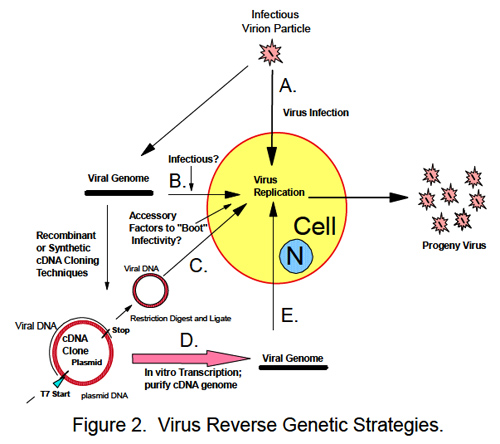
Figure 2. Virus Reverse Genetic Strategies
In the late 1970’s, a simple observation altered the course of virology research globally. Using a small dsDNA virus genome as a model (the Group I polyomavirus SV40) researchers cloned the viral genome into a bacterial plasmid and propagated the viral genome in bacteria. Upon isolation of the plasmid DNA from bacteria, restriction enzymes were used to excise the dsDNA viral genome, re-ligate the genome in vitro into a circular dsDNA and rescue virus following transfection of the genome into susceptible cells (Figure 2, Part C)(28). (Many advances in biotechnology have been, and continue to be, dependent upon this restrict-isolate-ligate technique, or variations of it.) Shortly thereafter, full length cDNAs of positive strand RNA genomes were isolated following reverse transcription, the cDNAs cloned and propagated in bacterial plasmids, and following introduction of full length DNA into eukaryotic cells, recombinant viruses were rescued from the transfected cultures, although very inefficiently. The major problems with this approach were the difficulty in generating the appropriate termini, accurate genome sequence, problems in nuclear transport of the full length RNA genome, and splicing of the viral genomic RNA. To rectify the efficiency problems, bacteriophage promoters (T7, SP6, T3) were introduced upstream of the cloned viral cDNAs, allowing in vitro transcription of full length RNA copies of the viral genome using the appropriate phage RNA polymerase, nucleotide triphosphates, and other constituents (Figure 2, Part D). The full length RNAs, near exact replicas of the viral genome, were highly infectious upon transfection of susceptible host cells (Figure 2, Part E)(2, 65, 66). The ability to clone full length copies of viral genomes allowed for ease of manipulation of the genome and the introduction of specific mutations. Recovered viruses contained the introduced mutations that were encoded within the full length cDNA clones, providing a ready means of performing detailed genetic analyses of virus replication and pathogenesis.
As noted earlier not all viral genomes are infectious, complicating the development of full length cDNAs and the recovery of recombinant viruses. Isolated dsRNA genomes from Group V negative sense RNA viruses are not infectious because the genome sequence cannot be translated directly into a functional replicase complex needed to transcribe the incoming genomic RNA. As Group V virions contain a replicase protein complex essential for transcription, genome infectivity requires that cells be co-transfected with plasmids that express the genomic RNA and plasmids expressing transcripts that encode the replicase protein complex are needed for genome infectivity (Figure 3a). For most group V viruses, both genome negative and positive sense RNA infectivity can be booted using this approach with most investigators expressing full length plus (coding) strands from the initial transcript. The plus strands are transcribed to full length negative strands, which are used to express the appropriate set of mRNA encoding the full component of positive and negative strand RNAs. Using this approach Schnell et al. successfully recovered the first recombinant negative stranded RNA virus, rabies virus, from a cloned cDNA, ushering in an era of Group V virus reverse genetics (68, 82). These findings were rapidly extended to other linear negative stranded RNAs like paramyxoviruses and then to segmented negative strand RNA viruses like influenza and other myxoviruses, and then select bunyaviruses and arenaviruses (20). Reverse genetic strategies for group V viruses with segmented genomes are most complex as multiple plasmids expressing copies of each genome segment must be simultaneously delivered to a cell along with the support plasmids encoding the transcriptase complex.
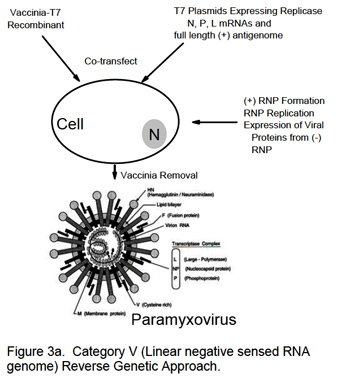
Figure 3a. Category V (Linear negative sensed RNA genome) Reverse Genetic Approach
Most of the RNA viruses have relatively small genomes (under approximately 20,000 bases or base-pairs). Viruses with extremely large genomes (over 100,000 base-pairs, e.g., herpes viruses, poxviruses, or ~20,000-30,000 base pairs, e.g., coronaviruses, filoviruses) have presented additional obstacles in the development of stable molecular clones. Generation of infectious clones for viruses encoding large RNA or DNA genomes is complicated by the need for sequence accuracy (e.g., incorrect sequences usually contain lethal mutations), the lack of suitable cloning vectors that stably maintain large DNA inserts, large genome size, and that the genomes oftentimes encode regions that are toxic or unstable in bacteria. In poxviruses for example, the ~200 kilobase pair (kbp) genome has covalently closed hairpin ends (structures formed by the DNA itself) that are required for genome replication and virion encoded products are also essential for booting genome infectivity (24).
Herpes virus genomes are ~150 kbp in size. One solution was to stably clone large viral genomes as bacterial artificial chromosome (BAC) vectors. BAC vectors are based on the replication of F factor in E.coli, which is tightly controlled and allows stable maintenance of large, complex DNA fragments up to 600 kbp and both herpesvirus and poxvirus genomes can be stably maintained in BAC vectors (17, 24). For Herpes viruses, BAC shuttle vector sequences encoding a marker are inserted by homologous recombination into the genome. Circular viral DNA, which is generated during the Herpes virus replication cycle, is purified from infected cells (so-called Hirt prep) and introduced in bacterial cells, which essentially generates a large plasmid containing the Herpes virus genome (49). As herpesvirus genomes are infectious, the BAC DNA sequences are rapidly lost after delivery to a suitable host cell, along with some surrounding viral sequences, because they are dispensable for viral DNA replication (71). Using the Cre/lox system (another basic tool of molecular biology), a self-recombining full length pseudorabies virus BAC was developed where the full length genome is automatically removed from the BAC sequences by the expression of Cre recombinase after transfection, reducing the potential for random deletions of viral sequences (72) (Figure 3b). Recombinant Herpes virus genomes that have been successfully cloned include mouse cytomegalovirus, herpes simplex virus 1, human cytomegalovirus, pseudorabies virus, and Kaposi’s Sarcoma virus (11, 24, 49).
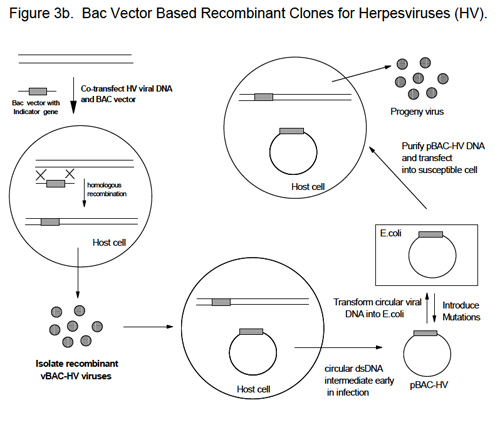
Figure 3b. Bac Vector Based Recombinant Clones for Herpesviruses (HV).
Poxvirus genome structure and replication modes make the development of an infectious poxvirus molecular clone an order of magnitude more difficult than generation of the Herpes virus molecular clone. Poxvirus genomes replicate in the cytoplasm and require several viral proteins to mediate mRNA transcription and a unique DNA-dependent RNA polymerase that are normally contained within the virion to initiate virus infection.
Consequently, purified poxvirus DNA is not infectious. In addition, the linear dsDNA genome has closed hairpins at each end of the genome that are essential for DNA replication. How were these problems solved? As described with Herpes viruses, a mini BAC encoding a marker called green fluorescent protein (GFP) was recombined into the thymidine kinase gene encoded in the vaccinia genome (a model for smallpox). Recombinant viruses harboring the BAC cassette were identified by GFP expression. However, transformation of Vaccinia BAC vectors into E.coli required conversion of the linear genome with covalently closed ends into a closed circular DNA. To accomplish this, Domi and Moss blocked late viral gene expression knowing that this favored additional recombination events that allowed head to tail concatamers of full length genome from which monomeric recombinant genome in a covalently closed circle would result, a favored genome orientation for insertion into E.coli. Transfection of VAC-BAC DNA into mammalian cells, previously infected with a helper fowl pox virus whose replication is defective in mammalian cells, allowed recovery of recombinant vaccinia virus (23, 24).
Although BACs are remarkably stable, both poxviruses and herpesvirus genomes contain repetitive sequence elements and other sequences that might be unstable with passage as no biological selective pressure exists to maintain virus genome sequence fidelity in E. coli. Because the large genome size makes it impractical to sequence the entire genome, in vivo pathogenesis studies have been used to demonstrate equivalent levels of pathogenicity and virulence between wildtype and recombinant herpes viruses, further supporting the hypothesis that BAC recombinant genomes are highly stable in E.coli (12). The availability of large dsDNA genomes in BACs provides two major opportunities for future research, the construction of expression vectors for treatment of human diseases and the mutagenesis of the viral genome for understanding gene function, virus replication and pathogenesis.
A second solution to large genome instability was developed using coronaviruses as models. Seven contiguous cDNA clones that spanned the 31.5 kilobase (kb) coronavirus genome (e.g., mouse hepatitis virus [MHV] or SARS-CoV) were amplified, isolated and ligated into standard polymerase chain reaction (PCR) cloning vectors (PCR is one technique used to amplify sequences that are rare and/or not available in large quantities, to provide enough material for subsequent experiments). The ends of the cDNAs were engineered with unique junctions, generated by class IIS restriction endonucleases like BglI or Esp3I. These enzymes leave asymmetric ends, which are designed to seamlessly reproduce the exact virus sequence, allow directional assembly of adjacent cDNA subclones, and direct the production of an intact full length cDNA construct of ~31.5 Kb in length. With enzymes like Esp3I, interconnecting restriction site junctions can be located at the ends of each cDNA and systematically removed during the assembly of the complete full-length cDNA product (Figure 4a). The availability of a contiguous set of DNAs containing unique interconnecting junctions provides for the systematic assembly of large DNA molecules greater than 1,000,000 base pairs by in vitro ligation (85). In the case of coronaviruses (Figure 4b), full length cDNAs are assembled that contain a T7 transcription site at the 5’ end of the genome. RNA transcripts driven from the full length cDNA were infectious upon delivery into susceptible cells (85, 87). Alternatively, coronavirus genomes can be stably cloned into BAC vectors. T7 or eukaryotic promoters encoded upstream of the viral sequences allow for the synthesis of full length RNA genome sequences, which are infectious upon introduction into cells (1).
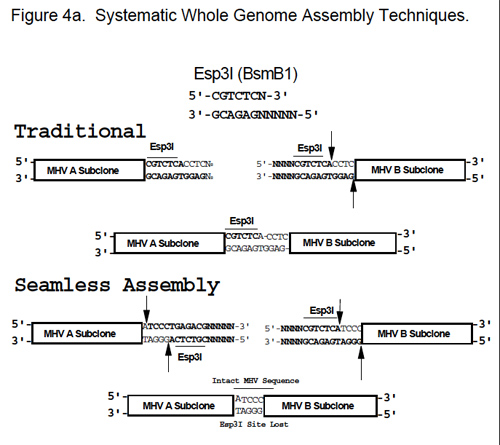
Figure 4a. Systematic Whole Genome Assembly Techniques
Seamless assembly (also called No See’m Sites (85)) cascades have been used to assemble full length cDNAs of the coronaviruses mouse hepatitis virus, transmissible gastroenteritis virus, infectious bronchitis virus and the SARS-CoV (85,86,87). Because certain type IIS restriction endonucleases (e.g., Esp3I, AarI, Sap1) recognize asymmetric binding sites and leave asymmetric ends, these enzymes can be used to create the unique interconnecting junctions, which can be subsequently removed from the final assembly product allowing for the seamless reconstruction of an exact sequence (Figure 4b). This approach avoids the introduction of nucleotide changes that are normally associated with building a full-length cDNA product of a viral genome. These non-palindrome restriction sites will also provide other novel recombinant DNA applications. For example, by PCR it will be possible to insert Esp3I or a related non-palindromic restriction site at any given nucleotide in a viral genome and use the variable domain for simple and rapid site-specific mutagenesis. By orientating the restriction sites as “No See’m”, the sites are removed during reassembly, leaving only the desired mutation in the final DNA product. The dual properties of strand specificity and a variable end overhang that can be tailored to match any sequence allow for Esp3I sites to be engineered as “universal connectors” that can be joined with any other four nucleotide restriction site overhangs (e.g. EcoRI, PstX1, BamH1). Alternatively, “No See’m” sites can be used to insert foreign genes into viral, eukaryotic, or microbial genome or vector, simultaneously removing all evidence of the restriction sites that were used in the recombinant DNA manipulation.
Finally, these restriction sites allow for the rapid assembly of small synthetically produced cDNAs into progressively larger cDNAs. For example, enzymes like AarI recognize a 7 nucleotide recognition sequence and leave a four nucleotide asymmetric end (usually). In a random DNA sequence, this site occurs every 8,000 base pairs or so. Using a recursive assembly cascade 2~256 different 8Kb cDNAs can be assembled into extremely large >1,000,000 bp DNAs designed in BACs for stable maintenance in bacteria (85-87).

Figure 4b. Systematic Assembly of Coronavirus Genomes.
At this time, well developed molecular clones have been constructed with representative viruses in most of the known virus families; specifically, the Groups I-IV genomes, thus providing a systematic approach for generating molecular clones of many Categories I, III, and IV BW agents. In addition, recent advances in synthetic biology provides promise for reconstructing microbial genomes de novo (15), as has been elegantly demonstrated with the recovery of recombinant poliovirus and ΦX174 viruses (14, 73) from synthetically derived genomes. In these instances, accurate sequences were available for de novo synthesis, as functional molecular clones had existed for both viruses for many years. Consequently, the combination of proof of principle, available templates for genome construction and sequence information make it likely that any virus genome could be synthetically reconstructed from sequence databases, assuming that the sequence is correct (18, 36).
C. Review of Controlled Viruses
The United States Department of Health and Human Services (HHS), the Centers for Disease Control and Prevention (CDC), and the United States Department of Agriculture (USDA) have identified bacteria, viruses, toxins, rickettsia, and fungi that pose a potential threat to public health or welfare. Some of these organisms are considered Select Agents and High Consequence Livestock Pathogens and all research laboratories with access to these agents must submits names and fingerprints of all individuals listed as working with Select Agents to the Department of Justice. Every person who enters a laboratory containing registered Select Agents must have FBI security clearance or be accompanied and monitored by such a cleared person. This includes visitors and employees performing routine cleaning, maintenance, and repairs. The CDC oversees and regulates all laboratories that possess or use select agents and the transfer of select agents and toxins that may be used to threaten the overall public health and safety as published in the Federal Register on March 18, 2005 (42 C.F.R. Part 73, 7 C.F.R. Part 331, and 9 C.F.R. Part 121) (Appendix 1). In addition, the Department of Commerce regulates the transport of many pathogenic agents deemed important for maintaining the public health or that could impact the economic vitality of the US. Many, but not all, overlap with the Select Agent List and the USDA High Consequence Livestock Pathogens. Finally, the National Institutes of Health has assembled a list of high priority agents for biodefense research, and provides special funding for basic science, vaccines and therapeutics. Select agents are typically grouped among category A agents that pose the most serious perceived risk to national security while category B agents include many important food and waterborne agents that are easy to disseminate. The category C agents are emerging pathogens of special concern or pathogens that could be engineered for mass dissemination.
All work with microbes that might be harmful to workers or to the environment is conducted according to a variety of regulations directed to the general area of “biosafety and containment”. What is important here is that biosafety and containment are accomplished through a suite of institutional and worker actions and these activities are referred to by the level of containment achieved. “Biosafety Level 1” (BSL-1) is the least stringent containment; BSL-4 the most stringent (used for the deadliest pathogens for which there are no treatments).
Priority viruses will be discussed according to the Baltimore Classification Scheme. The key columns in these tables are the last three, Nature, Laboratory, and Synthetic. A “yes” in Nature indicates that the virus can be found in nature (thus, all viruses on the list except smallpox, 1918 H1N1 and 1957 H2N2 influenza, and the 2002-2003 strain of SARS CoV). A “yes” under Laboratory means that the virus can be found in some kind of lab, be it a research laboratory, a reference laboratory (e.g., the American Type Culture Collection), a commercial laboratory, etc. This is virtually all viruses on the list (smallpox is closely guarded, and the recently resurrected 1918 influenza virus, at least for now, is in a limited number of known laboratories). Synthetic captures two characteristics. First, is it possible to synthetically construct a virus of a specific family? These are indicated in bold, and takes into account both whether a synthetic DNA construct can supply the appropriate nucleic acid, and if enough is known about the other aspects of booting the system that it is imaginable that a synthetic approach would be taken. Second, for the individual viruses on the list, the range of possibility takes into account both whether it is possible to construct, and whether this would be an attractive possibility compared to finding it in nature, or trying to steal it from a laboratory (in the case of a bioterrorist). So for example, even though foot-and-mouth disease virus is easy to find in nature and highly contagious, it is also easy enough to synthesize that bioterrorists hoping to hide their tracks may prefer the synthetic route.
The Group I agents include the dsDNA viruses contained among the Herpes viruses, Poxviruses and Asfarviruses (Figure 5). Herpes viruses contain linear dsDNA genomes of about 150,000 base pairs and include Herpes B virus (primate) and Malignant catarrhal fever viruses (swine), both of which are readily available in nature and for which culture conditions have been detailed in the literature. Herpes virus genomes are infectious; full length molecular clones and recombinant viruses have been described for several human and animal herpes viruses (72). Although molecular clones for Herpes B virus and Malignant catarrhal fever virus have not been described, a significant body of literature provides a theoretical template and guide for the development of similar constructs with a high probability of success.
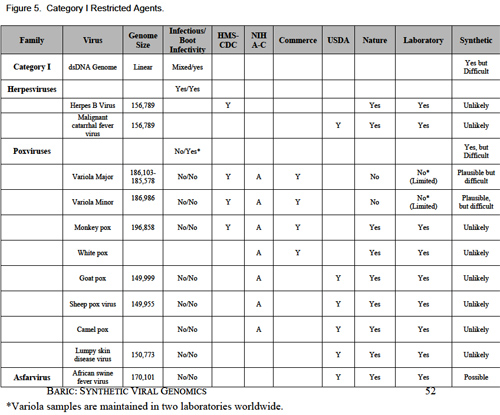
Figure 5. Category I Restricted Agents.
Poxvirus genomes range in size from 150,000 to 196,000 base pairs in length and the genomes are not infectious upon introduction into susceptible cells. However, poxvirus genome infectivity can be booted by coinfection with an avian poxvirus that has an abortive infection in mammalian cell lines, but provides essential proteins for transcribing the poxvirus genome. A molecular clone has been described for vaccinia virus, providing a theoretical template for guiding similar technology with other members in the family (23, 24). Poxviruses like Variola major and Variola minor (smallpox) and monkey pox viruses are select agents. Although most poxviruses can be readily found in nature and/or are maintained in laboratory settings, Variola major and minor are notable exceptions that are thought extinct in the wild. These two viruses are maintained in high security facilities in the US and Russia and it is very unlikely that these agents can be recovered from natural settings.
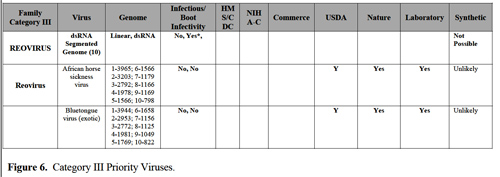
Figure 6. Category III Priority Viruses.
Group III priority agents include the reoviruses African horse sickness and exotic bluetongue strains, which primarily infect domesticated animals (Figure 6). Reovirus genomes contain ten segments of double stranded RNA and these genomes are not infectious in isolation. Reproducible schemes to boot reovirus genome infectivity have recently been developed by the Dermody laboratory. Although these viruses are available in nature and in laboratory settings, the inability to initiate genome infectivity had hampered the successful development of reverse genetic approaches and molecular clones. Consequently, the use of natural or laboratory acquired strains represented the most likely approach to acquiring these agents for bioterrorism purposes, although the reovirus reverse genetic system should be an appropriate template for developing molecular clones to other reoviruses.
Group IV viruses contain single stranded positive polarity RNA genomes and include agents in the calicivirus, potyvirus, picornavirus, alphavirus, flavivirus and coronavirus families (Figure 7). These viruses have dramatically different virion structures, genome organizations, and transmission modes between hosts; they target different tissues, display different virulence and pathogenic determinants and use different replication strategies upon entry into susceptible cells. Common features, however, include an infectious positive sense RNA genome and relatively straightforward and well developed approaches for obtaining full length cDNA clones from which recombinant viruses can be easily isolated in culture. In most cases these viruses replicate efficiently in culture, and animal models of disease exist, allowing for easy cultivation, maintenance, and testing in a laboratory setting. A general rule of thumb is that the BSL2 positive single stranded RNA (e.g., human noroviruses) pathogens are more readily accessible than the BSL3 pathogens (e.g., SARS-CoV, VEE, etc.) in laboratory settings. BSL4 pathogens are the least accessible. Poliovirus, which is targeted for eradication, is not included among any of the high priority pathogen lists but has been synthetically reconstructed by the Wimmer laboratory. Wild poliovirus is eradicated from the North and South American continents and Europe, but is still prevalent in Africa and parts of Asia. The virus has been present in many laboratories throughout the world, although current efforts are aimed at limiting the availability of wildtype stocks to a few locations in the US. Should eradication efforts prove successful, poliovirus should almost certainly be listed as a high priority agent. In the future, poliovirus might represent a likely candidate for synthetic reconstruction efforts because whole genome sequence is available, genome size is small and could be purchased for about $10,000 US dollars, and synthetic polioviruses have been reconstructed in the laboratory. This possibility, however, may be several decades away and is also dependent upon an end to global vaccination efforts.
The Group IV viruses are also very abundant in nature and many are present in laboratories. The main exception is the human 2002-3 SARS-CoV epidemic strain that is likely extinct in the wild, but is present in many laboratories throughout the world. Globally, most SARS-CoV isolates were late phase epidemic strains because many early and zoonotic (animal) isolates were never successfully cultured and not distributed outside of China (19, 41). Molecular clones have been described for prototype animal caliciviruses, picoronaviruses, potyviruses, alphaviruses, flaviviruses and coronaviruses, including many, but not all of the agents of interest in Figure 7. At this time, molecular clones for human noroviruses have not been successfully developed.
Group V viruses contain a single stranded negative polarity RNA genome and include members of the bunyavirus, arenavirus, filovirus, paramyxovirus, rhabdovirus, and influenza virus families (Figure 8, below). As with the group IV viruses, these viruses differ dramatically in virion structure, genome organization, transmission modes, human disease severity, virulence and pathogenesis. In general, negative stranded RNA genomes are either nonsegmented and linear (e.g., paramyxovirus, filoviruses, rhabdovirus) or segmented and linear (e.g., bunyavirus, arenavirus, myxoviruses). These viruses are readily found in nature either in human and animal hosts or vectors; all of which have been well described in the literature. Most are easily cultured in laboratory settings. Again, laboratory availability diminishes with increased BSL ratings, so that BSL3 (e.g., 1918 influenza, Rift Valley Fever) and BSL4 (e.g., Ebola, Marburg, Lassa Fever, etc.) are the least available. The exceptions include the 1918 Spanish influenza virus and H2N2 (1957 pandemic) Asian influenza viruses which are likely extinct in the wild. The 1918 Spanish influenza was resurrected from a molecular clone and is only available in a few laboratories worldwide, but the H2N2 strain is more prevalent in laboratory settings (81). Both viruses are likely capable of producing pandemic disease, as the Spanish Flu H1N1 and Asian H2N2 strains have not circulated in human populations for over 90 and 50 years, respectively. Reverse genetics systems for prototypic members of each virus family have been reported in the literature although success is more rare with arenaviruses and bunyaviruses. In contrast, well documented reverse genetic systems have been described for paramyxoviruses, rhabdoviruses, myxoviruses, and filoviruses providing clear templates for reconstruction of synthetic viruses.
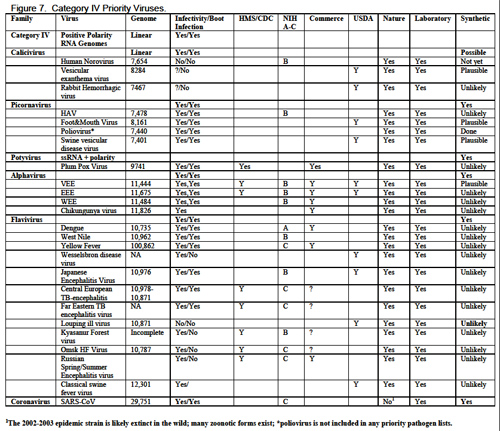
Figure 7. Category IV Priority Viruses.
Although many Category I-V agents are available in laboratory settings, serial passage of virus in cell culture oftentimes selects for “culture adapted” variants that display altered or reduced pathogenicity in the original host. In fact, serial passage in cell culture or alternative animal model has been used to attenuate virus pathogenesis and was used as a method to develop live attenuated poliovirus and measles virus vaccines. Consequently, laboratory strains may not reproduce wildtype virus pathogenicity and virulence when reintroduced into the natural host and may not represent the preferred source of starting material for bioterrorism applications.


